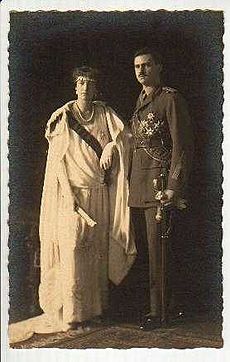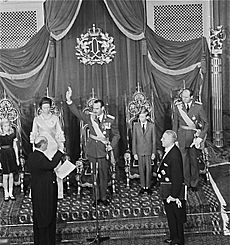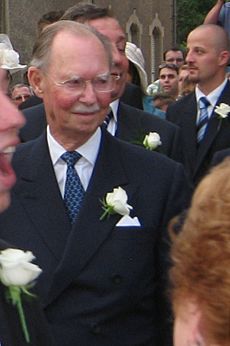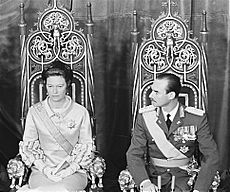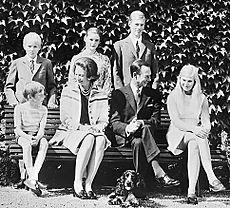Jean, Grand Duke of Luxembourg facts for kids
Quick facts for kids Jean |
|||||
|---|---|---|---|---|---|
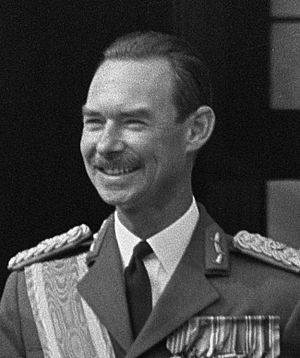
Jean during a September 1967 state visit to the Netherlands
|
|||||
| Grand Duke of Luxembourg | |||||
| Reign | 12 November 1964 – 7 October 2000 |
||||
| Predecessor | Charlotte | ||||
| Successor | Henri | ||||
| Prime Ministers | Pierre Werner Gaston Thorn Jacques Santer Jean-Claude Juncker |
||||
| Born | 5 January 1921 Berg Castle, Colmar-Berg, Luxembourg |
||||
| Died | 23 April 2019 (aged 98) Luxembourg City, Luxembourg |
||||
| Burial | 4 May 2019 Notre-Dame Cathedral, Luxembourg City, Luxembourg |
||||
| Spouse | |||||
| Issue |
|
||||
|
|||||
| House | Nassau-Weilburg (official) Bourbon-Parma (agnatic) |
||||
| Father | Prince Felix of Bourbon-Parma | ||||
| Mother | Charlotte, Grand Duchess of Luxembourg | ||||
| Religion | Catholicism | ||||
| Signature |  |
||||
Jean (born Jean Benoît Guillaume Robert Antoine Louis Marie Adolphe Marc d'Aviano; 5 January 1921 – 23 April 2019) was the Grand Duke of Luxembourg. He ruled from 1964 until he stepped down in 2000. A Grand Duke is the ruler of a small country called a Grand Duchy. Jean was the first Grand Duke of Luxembourg whose family line came from France.
Jean was the oldest son of Grand Duchess Charlotte and Prince Felix of Bourbon-Parma. He went to school in Luxembourg and later in England. In 1938, he was officially named the Hereditary Grand Duke. This meant he was next in line to the throne. During World War II, when Germany took over Luxembourg, Jean and his family had to leave the country. He studied in Canada and then joined the British army in 1942. He helped fight in the war, including the Normandy landings and the Battle for Caen. He also helped free Luxembourg.
On 9 April 1953, Jean married Princess Joséphine-Charlotte of Belgium. They had five children together. When his mother, Grand Duchess Charlotte, stepped down on 12 November 1964, Jean became the new Grand Duke. He ruled for 36 years. On 7 October 2000, he also stepped down, and his son, Henri, became the Grand Duke.
Contents
Early Life of Grand Duke Jean
Jean was born on 5 January 1921, at Berg Castle in central Luxembourg. He was the first child of Grand Duchess Charlotte and Prince Félix of Bourbon-Parma. Because he was the oldest child of the ruler, he was the heir apparent from the day he was born. This meant he was expected to become the next Grand Duke. One of his godparents was Pope Benedict XV.
Jean went to primary school in Luxembourg. He then finished his secondary education at Ampleforth College. This was a Roman Catholic boarding school in the United Kingdom. On his 18th birthday, 5 January 1939, he was officially called 'Hereditary Grand Duke'. This title showed his place as the future ruler.
Grand Duke Jean and World War II
On 10 May 1940, Germany invaded Luxembourg. This started a four-year period where Germany controlled the country. The Grand Ducal Family had been warned about the invasion. They managed to escape the night before it happened. First, they went to Paris, France. A few weeks later, they had to leave France too. They got special papers to travel to Portugal in June 1940.
After traveling through Portugal, the family went to New York City. They stayed in a rented home in Brookville, New York. Jean studied Law and Political Science at Université Laval in Quebec City, Canada.
In November 1942, Jean joined the British Army as a volunteer. He became part of the Irish Guards. He trained to be an officer at the Royal Military College, Sandhurst. On 30 July 1943, he became a lieutenant. He was promoted to captain in 1944. Jean landed in Normandy, France, on 11 June 1944. He took part in important battles like the Battle for Caen. He also helped free Brussels and, on 10 September 1944, he helped free Luxembourg. He continued to fight in the war, moving into Germany. Jean left the British Army on 26 June 1947. From 1984 until he stepped down as Grand Duke, he was the Colonel of the Regiment for the Irish Guards. He often rode in parades behind Queen Elizabeth II.
Jean's Time as Grand Duke
Jean became the Lieutenant-Representative of the Grand Duchess on 28 April 1961. This meant he took on some of his mother's duties. He became Grand Duke when his mother, Charlotte, Grand Duchess of Luxembourg, stepped down on 12 November 1964. On the same day, he was made a General in the Armed Forces of Luxembourg.
When he became Grand Duke, Jean focused on two main goals. He wanted to make sure his people were doing well. He also wanted to help unite Europe. A French President once said that if Europe needed a king, it would be the Grand Duke of Luxembourg. During his time as ruler, Luxembourg changed a lot. It went from a small industrial country to a major international financial center. In 1986, he received the Charlemagne Prize. This award was for his work in bringing European countries closer.
Jean's reign was a very good time for Luxembourg. The country was very stable in its politics, economy, and social life. This was partly thanks to the Grand Duke and his wife. He stepped down on 7 October 2000. His son, Henri, then became the new Grand Duke. Luxembourg's modern art museum, Mudam, was named "Musée d'Art Moderne Grand-Duc Jean" to remember his 36-year rule. It opened in 2006 with him there.
Later Life and Death
In 2002, Grand Duke Jean and Grand Duchess Joséphine Charlotte moved to Fischbach Castle. After his wife passed away in January 2005, the Grand Duke continued to live there alone. On 27 December 2016, Grand Duke Jean was taken to the hospital. He had bronchitis. He left the hospital on 4 January 2017, just before his 96th birthday.
His Passing
Grand Duke Jean passed away on 23 April 2019, at 12:25 AM. He was 98 years old. His family was with him. He had been in the hospital for a lung infection. By the time he died, he was the oldest living former ruler in the world.
His funeral was held on Saturday, 4 May. It took place at the Notre-Dame Cathedral, Luxembourg. The country had a 12-day period of mourning before the funeral.
Tributes to Grand Duke Jean
Many people shared their sadness and respect after Grand Duke Jean's death. Jean-Claude Juncker, who was the head of the European Commission and a former Prime Minister of Luxembourg, said it was a "great loss." He called Jean a man of "commitment, kindness and courage."
Luxembourg's Prime Minister, Xavier Bettel, spoke about Jean's service in World War II. He said, "Grand Duke Jean fought for our freedom, for our independence and for the unity of our country." He also called him "a great statesman, a hero, an example – and a very beloved and gracious man."
The royal families of Belgium, the Netherlands, and the United Kingdom also sent their condolences. They spoke about his courage, dignity, kindness, and humanity. The International Olympic Committee also paid tribute. Grand Duke Jean had been a member since 1946. They remembered him as a "calm and well-balanced person" who was respected for his honesty.
Marriage and Family Life
In October 1952, Jean became engaged to Princess Joséphine-Charlotte of Belgium. She was his third cousin. She was the only daughter of Leopold III, King of the Belgians. Some people thought their marriage was arranged to improve relations between Luxembourg and Belgium. But it soon became clear that they were in love and had been friends for a long time.
They were married in Luxembourg on 9 April 1953. The ceremonies took place at the Grand Ducal Palace, Luxembourg and later at Luxembourg's Notre-Dame Cathedral, Luxembourg. Their marriage helped ease tensions between Luxembourg and Belgium. The couple had five children, 22 grandchildren, and 28 great-grandchildren:
- Archduchess Marie-Astrid of Austria (born 17 February 1954). She married Archduke Carl Christian of Austria in 1982. They have five children and 13 grandchildren.
- Henri, Grand Duke of Luxembourg (born 16 April 1955). He married María Teresa Mestre y Batista in 1981. They have five children and six grandchildren.
- Prince Jean (born 15 May 1957). He married Hélène Vestur in 1987 and they divorced in 2004. They have four children and seven grandchildren. He remarried Diane de Guerre in 2009.
- Princess Margaretha (born 15 May 1957). She married Prince Nikolaus of Liechtenstein in 1982. They have four children and two grandchildren.
- Prince Guillaume (born 1 May 1963). He married Sibilla Weiller in 1994. They have four children.
See also
 In Spanish: Juan de Luxemburgo para niños
In Spanish: Juan de Luxemburgo para niños


